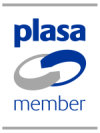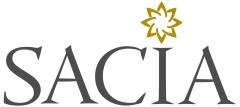01 June 2009
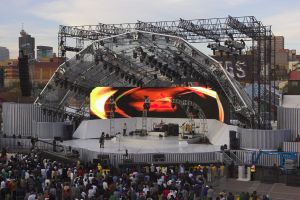 Gearhouse South Africa supplied stage and set design plus all technical production – staging, lighting, audio, video, power, etc – to the 2009 Africa Day Concert staged in Mary Fitzgerald Square, Newtown, downtown Johannesburg. The show included a fantastic line-up including the Parlotones, Asa from Nigeria, Classix, Yuri de Cuhna from Angola, Awadi from Senegal, Gang Be from Benin, the Soweto Gospel Choir and many more, and was televised live on SABC.
Gearhouse South Africa supplied stage and set design plus all technical production – staging, lighting, audio, video, power, etc – to the 2009 Africa Day Concert staged in Mary Fitzgerald Square, Newtown, downtown Johannesburg. The show included a fantastic line-up including the Parlotones, Asa from Nigeria, Classix, Yuri de Cuhna from Angola, Awadi from Senegal, Gang Be from Benin, the Soweto Gospel Choir and many more, and was televised live on SABC.
The innovative stage and set design was created by Gearhouse’s Tim Dunn. He wanted a distinctive, stylish structure based on mellow curves and clean lines that complemented the surrounding urban environment.
He achieved this using several integrated elements, including a 25 metre domed roof – essentially the trussing structure from an In2Structures MaxiDome – with clear skins. The downstage elements were flown from the trussing superstructure of a 16 metre high StageCo roof system above, and it was also supported by 4 ground support legs per side. For convenience, it was landed onto the stage by crane. The total stage width including wings was an impressive 38 metres and was constructed by Gearhouse’s set building company, SDS.
Four upstage/downstage lighting trusses were sub-hung from the StageCo spans above the Dome roof, enabling Dunn to light the stage action through the clear skins, adding an extra spatial dimension to the event venue.
Dunn designed lights, which included lighting positions along 5 ‘finger’ trusses rigged below the Dome roof. The metalwork of the Dome roof was also used – maximising lighting coverage across all areas of the stage and its large, gently curved thrust. “I wanted a scenic design that looked fresh, new and relevant, that fitted the surroundings, was practical and easy to negotiate for all the band changeovers, and where any position could be hit from virtually any light source wherever it was on the rig,” he explains.
The lighting metalwork was completed with 4 onstage ‘hooked’ trusses that curved round above the upstage band area, enabling the space to be shrunk down for more intimate performance moments when the forestage was not being utilised. “The scenic design also had to account for the diversity of the line up, look good for the 15,000 people who would be there on the day as well as several million watching on TV,” says Dunn
With a large portion of the show taking place in daylight, video visuals were also a massive part of the aesthetics
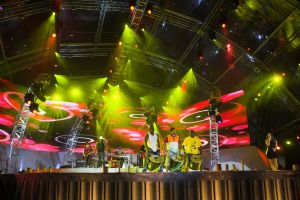 Dunn integrated 168 panels of Lighthouse R16 daylight screen on a raised ground supported platform running around the back of the stage, further defining the gentle curvature of the overall design. Even though this spanned the whole stage width, it’s slim conformation ensured it was non intrusive, totally avoiding the ‘TV set’ look phenomenon.
Dunn integrated 168 panels of Lighthouse R16 daylight screen on a raised ground supported platform running around the back of the stage, further defining the gentle curvature of the overall design. Even though this spanned the whole stage width, it’s slim conformation ensured it was non intrusive, totally avoiding the ‘TV set’ look phenomenon.
The entire stage and onstage set pieces were finished in white Harlequin Hi Shine PVC, it’s simplicity and reflective surfaces the perfect complement to the colourful costumes and props of an eclectic line up of pan African bands. It also responded spectacularly to saturated colour washes from the lights. The stage front and two levels of curved wings radiating out to the sides were clad in printed PVC fashioned with a grey and silver corrugated pattern that was truly 3D in effect and brought a bit of an edge to the picture. Printed cladding is a finishing trademark of all Dunn’s scenic designs, that final 5 per cent of the look that unifies all the elements.
At FOH, lighting and visuals were run off two grandMA full size consoles. Lighting was programmed by Dunn, and run for the show by Sean Rosig, while Dunn programmed for the closing ceremony of the Indian Premiere League cricket series in nearby Wanderers Stadium, which he also designed and which took place the next day.
Visuals appearing on the onstage LED screen were programmed and run by Marcel Wijnberger of Gearhouse Media. He created funky special content which was run through the first of two grandMA video servers loaded with the new MA2 video software. This facilitated the use of Alpha-channelled stills to generate masks and other effects, and combined seamlessly with the lighting and set aesthetics.
A second grandMA video server was used to pixel-map 105 i-Pix Satellite LED ‘bricks’ that were attached to the underside of the roof, spaced out to form a canopy of coverage. Video could be run through these to match with the screen output, and they were also run as pure lighting effects. The idea was that when illuminated, the roof structure completely vanished, adding yet another layer of dynamics and shape to the stage.
Only playback video appeared on the main screen, routed through a Barco Encore multi-screen system operated by Wayne Susman and Kefiloe Kgoadi from Gearhouse AV. They also received a TX feed from SABC which was output to two 4 x 3 panel Lighthouse R16 side screens (also 16:9 aspect ratio). They ran fibre optic between all screens and FOH for best quality and stability. All screens were supplied by LEDVision, also a Gearhouse company.
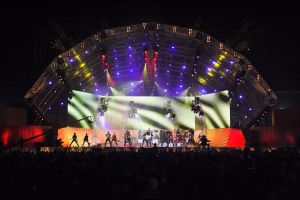 The lighting rig included 140 moving lights – a mixture of Robe ColorSpot and ColorWash 2500 and 700E ATs, Martin Professional MAC 2K Profiles and Washes, plus MAC 250 Washes.
The lighting rig included 140 moving lights – a mixture of Robe ColorSpot and ColorWash 2500 and 700E ATs, Martin Professional MAC 2K Profiles and Washes, plus MAC 250 Washes.
Twelve of the Robe ColorWash 2500s were rigged above the clear roof, along with 16 bars of 6 PARs, they were used for subtly diffused general stage washes which looked particularly interesting on wide angle onstage camera shots.
Below this, spread out across the 5 fingers were 36 MAC 2K Profiles and 36 Washes. The 4 ground supported curved trusses over the upstage band area were loaded with a total of 16 Robe ColorWash and Spot 700E ATs – 8 of each type.
The MAC 250s were spread out all over the stage and used for set texturing and highlighting. There were also 18 8-cell Molefeys trimming the front edge of the Dome to light the audience.
 Audio was supplied by Gearhouse Audio, with Llewellyn Reinecke running FOH and Tom Gordon on monitors, both using Yamaha PM5D consoles. At FOH, there was also a Yamaha LS9 console for extras like MCs and playback channels.
Audio was supplied by Gearhouse Audio, with Llewellyn Reinecke running FOH and Tom Gordon on monitors, both using Yamaha PM5D consoles. At FOH, there was also a Yamaha LS9 console for extras like MCs and playback channels.
The arrays were 12 VDOSC elements on V towers on the outer edges of the stage, with 8 SB28 subs a side ground stacked. Six dV-DOSC infills were used for front fills, together with 2 SB28 subs underneath the centre of the stage for additional oomph!
System EQ was via Lake Dolby processors with a wireless tablet remote.
For monitors there were 20 L-Acoustics High-Q wedges, with Turbo Floodlight side fills. The High-Q’s were powered by LA24 amps, and LA8s drove all the other sound elements.
Monitor world was neatly concealed in a tent offstage left, viewing the stage action via camera feeds and plasma screens. The challenge for sound world was to deal with a wide range of bands and meet the demands of the TV production in addition to the live audience.
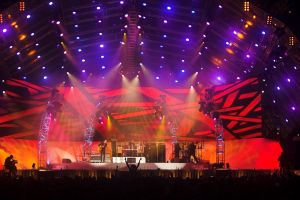 Gearhouse’s project manager Michael Lewis co-ordinated and ran the site and crew over the duration of the event and for the get in and out, and the show was produced by Brad Holmes who also runs the nearby Bassline club. He comments, “I feel really safe working with Gearhouse on these types of events, I know I can trust them to deliver the very best design quality, service and technology in a great package”.
Gearhouse’s project manager Michael Lewis co-ordinated and ran the site and crew over the duration of the event and for the get in and out, and the show was produced by Brad Holmes who also runs the nearby Bassline club. He comments, “I feel really safe working with Gearhouse on these types of events, I know I can trust them to deliver the very best design quality, service and technology in a great package”.
It was been hailed as one of the most successful Africa Days ever, and the third year that Gearhouse has successfully serviced the high profile central Johannesburg show which celebrates the diversity of African musical culture. The 2009 show was presented by SABC2 in association with the City of Johannesburg, Johannesburg Promusica and the Department of Arts & Culture. Hosts for the evening were Kenneth Nkosi and Shane Maja.
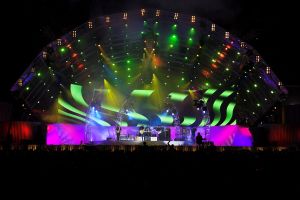 Africa Day is the annual commemoration of the founding of the Organisation of African Unity (OAU) on 25th May 1963. The OAU was later succeeded by the African Union, which aims to secure democracy, human rights and sustainable economies in Africa, especially through ending intra-African conflict and creating an effective common market.
Africa Day is the annual commemoration of the founding of the Organisation of African Unity (OAU) on 25th May 1963. The OAU was later succeeded by the African Union, which aims to secure democracy, human rights and sustainable economies in Africa, especially through ending intra-African conflict and creating an effective common market.


